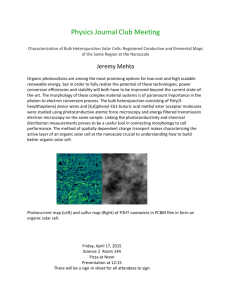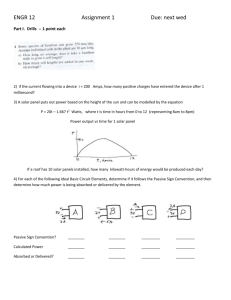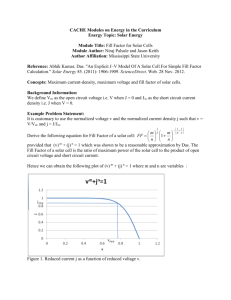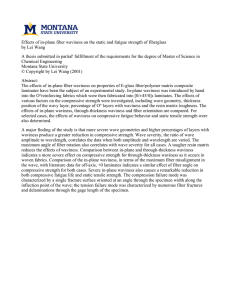Modeling the Effect of Morphology on Organic Photovoltaic Bulk-heterojunctions Kathleen Ellis
advertisement
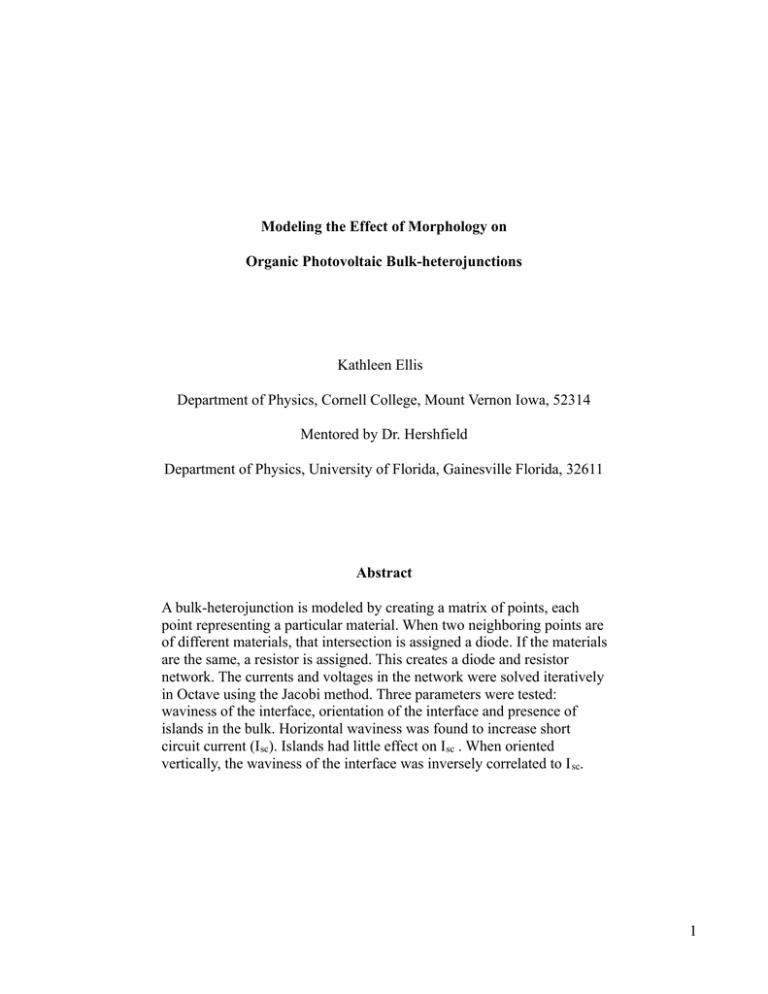
Modeling the Effect of Morphology on Organic Photovoltaic Bulk-heterojunctions Kathleen Ellis Department of Physics, Cornell College, Mount Vernon Iowa, 52314 Mentored by Dr. Hershfield Department of Physics, University of Florida, Gainesville Florida, 32611 Abstract A bulk-heterojunction is modeled by creating a matrix of points, each point representing a particular material. When two neighboring points are of different materials, that intersection is assigned a diode. If the materials are the same, a resistor is assigned. This creates a diode and resistor network. The currents and voltages in the network were solved iteratively in Octave using the Jacobi method. Three parameters were tested: waviness of the interface, orientation of the interface and presence of islands in the bulk. Horizontal waviness was found to increase short circuit current (Isc). Islands had little effect on Isc . When oriented vertically, the waviness of the interface was inversely correlated to I sc. 1 Introduction The increased importance placed on renewable energy over the past couple of decades has spurred new research into solar cells. The discovery of carbon nanotubes and semiconducting organic polymers has opened the door to new types of solar cells including Organic Photovoltaics. Organic Photovoltaic (OPV) devices promise a cheaper future for solar cells because they do not rely on expensive silicon as traditional solar cells do. In a bulk heterojunction OPV, two different materials are mixed together, usually spin coated onto a conducting substrate1-2 to form “the bulk”. One of the materials conducts electrons and the other material conducts holes. Both materials are capable of absorbing a photon. When the photon is absorbed into the material, it excites an electron leaving a hole in the valence band. In organic materials, the hole and the electron stay loosely bound forming what is called an exciton. The two materials are chosen in such a way that the difference between their HOMO (Highest Occupied Molecular Orbital) and LUMO (Lowest Unoccupied Molecular Orbital) levels optimizes the separation of these exciton pairs at the interface. 5 The electric field at the interface creates the separation of excitons into free carriers.3 Initially, OPVs were extremely inefficient due in part to the limited area in which excitons were separated. In an attempt to increase the efficiency, the two materials were mixed together to create an interface that had more surface area. 4 This problem is unique to Organic photovoltaics because the depletion region (region on either side of the interface in which the excitons are broken into free carriers) is of the order of nanometers which is much smaller than traditional silicon solar cells. Figure 1 is one example of how two materials could be mixed together. The materials could be mixed in many different ways. The way in which they are mixed is called the morphology of the sample. One of the most important tools used to analyze solar cells is an IV curve because it shows the power output of the cell at varying loads. An IV characteristic is a current vs. voltage plot. When the two materials in a bulk heterojunction are combined in a non-uniform way, different parts of the sample 2 Figure 1: An example of a possible morphology for a bulk heterojunction. The blue represents an n-type material and the grey represents a p-type material. have different IV characteristics. 4 Our model explores the effect the morphology of the sample has on the IV characteristic. While some models examine the behavior of OPVs using the drift-diffusion equation along with density of holes and electrons based on dissociation rates of excitons, 5-6 we employed a much simpler approximation due to the potential to study morphology on larger systems. By modeling the solar cell by a discretized diode and resistor network, I was able to determine how the waviness and orientation of the interface as well as the presence of islands effects the IV characteristic of the solar cell. Methods The Model The model used for the solar cell was a diode and resistor network. In order to test a particular interface, a sample morphology matrix (a sample is shown in Figure 2) was formed to represent the different materials in the cell. These matrices were composed of four different materials: two lead materials (one that conducted holes and one that conducted electrons) and two polymer materials at the junction of which the current was created. The samples were visualized like the one seen in Figure 2. Each junction between materials was represented by a resistor (Equation 1) or a diode with I1 added (Equation 2) to represent the current coming into the cell via the separation of excitons at the interface. I =GV I =I 0 ( e x p (bV )−1)−I 1 (1) (2) 3 Figure 3: A sample circuit model illustrating how the resistor-diode network was formed. Figure 2: Image of sample morphology matrix for a 20 X 20 sample with a straight interface. The four colors each represent a different material. Dark blue conducts holes and absorbs photons, yellow is a lead that conducts holes, light blue conducts electrons and absorbs photons, and red is a lead that conducts electrons. The circuit element that represented each junction is shown in Figure 3. Each intersection was assigned a particular IV characteristic corresponding to its circuit element, then the overall IV characteristic of the sample was found using the Jacobi method 8 (explained further in the program section). Organic semiconductors have a limited number of free charge carriers due to the strong binding of excitons. This causes most of the charge carried to come from the leads, an effect known as space charge limited transport. In the space charge limited domain, the charge carriers move as a result of drift and diffusion. There is debate about whether the diffusion of charge carriers contributes significantly to current flow in OPVs.1,5,7 In our model we decided, for ease of calculation, to leave off the diffusion term as was done by Koehler et al.1 Program In the computer program, the solar cell was modeled by a matrix with each kind of material represented by a different integer. Each color in Figure 2 is represented in the code as a 1 (light blue), 2 4 (dark blue), 3 (yellow) or 4 (red/brown). In order to solve for the current and voltage at each point in the sample, each junction was assigned an equation which allowed the current to be found for a given voltage. Equation 1 was used for the resistors (junctions between 2-2 2-3 3-4 2-4 3-3 and 4-4) and Equation 2 for the diodes (1-2 junctions). In order to simulate the conduction of holes in one lead and the conduction of electrons in the other, the 1-4 and 2-3 junctions were given G values 1000 times that of the 1-3 and 2-4 junctions. The equations were used at their respective junctions to find the voltage because the net current at a particular point must always be zero. The initial voltage at each point was determined by a linear voltage profile across the cell with the boundaries at V=0 and V=3. This initial guess allowed the iterative use of Kirchoff's point Rule (see below). This process known as the Jacobi method. In Equation 3 below, Gabove is the conductance of the point above the point in question, V above is (3) the voltage of the point above the point in question and V is the new voltage guess that is being solved for. The other terms in equation 3 are the same as the first line of the equation except they account for the points below, left and right of the center point respectively. At each step of the iterative process V is solved for using the Vabove , Vbelow , VsileL and VsideR from the previous iteration. This continues until the convergence criterion is met. The convergence criterion we used was that the change in the current at every point added up to less than one 6 millionth of the total current going into each point; in other words, the current will not change a considerable amount even if more iterations were performed. After the current has converged, the current and voltage values for each point in the sample are known. The iterative two dimensional code I used was created by Dr. Hershfield. A flowchart of the steps in the program is provided in Figure 4. In order to create an IV characteristic, the current through the sample was found for voltages applied to the cell ranging from -3V to 3V. These programs were run in Octave 5 on an Ubuntu Linux system. Figure 4: Flowchart for the program used to determine current and voltage at each point in the cell. After initializing the parameters including an initial guess for the voltage profile of the sample the voltage is solved for iteratively using Equation 3. The current is then found using Equations 1 and 2. Initialization In the trial runs of the program, Io, I1, and b were all set to 1 for simplicity. In order to make it more representative of a organic bulk heterojunction, Io ,I1 and b values were obtained by a curve fit to approximate data points from Kostner et al.'s IV characteristic under light current. The values obtained were Io= 0.243, b= 5.46 and I1= 27.62; the curve was fit with an R2 value of 0.982. 6 Results and Discussion Straight interface The straight interface matrix is representative of a bilayer organic solar cell. The straight interface serves as a control to determine the difference in performance as the interface is varied. Figure 5 shows an image of the straight interface and an IV characteristic for this matrix. The short circuit current, Isc, is the current through the cell when the voltage is equal to zero. The straight interface was useful for determining convergence times. The program was run on the straight interface for 10x10, 50x50, 70x70, and 100x100 matrices in order to determine the ideal size for the time available. When running the 100x100 matrices, it was discovered that the original convergence criterion, which was based on the voltage, was not adequate because the current did not converge. When the convergence criterion was changed so that it was dependent on the current, the straight interface 100x100 matrix converged. However for 100x100 matrices it took over a week to run the program for wavy interfaces when doing IV curves for multiple sample morphologies. Thus, a 20x20 size was chosen for further testing. Figure 5: IV curve for straight interface. Inset is image of the sample morphology matrix (a straight interface) used to calculate the IV curve. The straight interface IV curve serves as a reference when varying different parameters. 7 Waviness for small systems In order to test the effects of a wavy interface on the IV characteristic, a program was made that created a 20 by 20 matrix of 1s and 2s with a sine wave interface. An IV curve was measured for four different wavelengths of sine waves interfaces. The wavelength of the sine waves was characterized by an integer w where the wavelength equals two times the width of the sample divided by w. By this definition the curvature of the interface increases as w increases, so w is used as a measure of the “waviness”. Figure 6 shows that as w increases, the amount of short circuit current also increases. The fact that the current is “negative” does not matter because it is just a measure of which way the holes and electrons are moving. This result agrees with what was expected because as the “waviness” as measure by w increased, the interface length and photocurrent generation also increased. Even for the smallest value of w, the Isc for the horizontal wavy interface is still larger than the I sc value for the straight interface. Despite the fact that the short circuit current increases, it is unclear whether the overall power output of the cell also increases because the fill factor decreases as w increases. Figure 6: IV curves for horizontally wavy matrices as w was increased. Inset is the sample morphology matrix for w=3. The graph shows that as w increases the short circuit current also increases. 8 Vertical waviness In order to determine whether the orientation of the 'waviness' had an effect on the phenomenon observed with horizontal waviness, the matrices were rotated so that the waviness was oriented vertically. The sample morphology matrix is show in the inset to Figure 7. IV curves were taken using 20x20 matrices, where again w represented the period of the sine wave that formed the interface. Figure 7 shows the IV curves for w = 1,2,3,4,5 and the sample morphology matrix for w=3. Comparing Figure 6 and Figure 7 reveals that the IV curves for the vertical waviness differ substantially from the IV curves for horizontal waviness. The short circuit current values of the horizontal waviness were larger than those of the vertical waviness matrices. The short circuit current values decreased with increasing w in the vertical case, and all were lower than the short circuit current for straight interface. It appears vertical waviness has a negative effect on the efficiency of the cell. Figure7: IV curves for vertically oriented waviness as w was increased. The inset shows the sample morphology matrix for w=3. The graph shows that as the interface becomes more wavy the short circuit current decreases. 9 Holes In order to test the effect of islands of material 2 in material 1 and vice versa, a series of 20x20 matrices were made identical to the horizontal waviness matrices except holes were added. The holes were added in such a way that wherever there was a peak or dip, a hole was added. This is illustrated for w=3 in the inset to Figure 8. Figure 8 also shows the IV characteristics for w= 1,2,3,and 4. Since w is a measure of the period and hence the number of peaks, as w increased, so did the number of holes. A comparison of holes (Figure 8) to no holes (Figure 6) shows a very slight decrease in I sc when holes are added. For w=1 there was a 0.004% percent decrease in Isc and for w=4 the percent decrease in short circuit current with holes was 0.036%. Figure 8: IV curves for horizontally wavy matrices with holes as w was varied. The inset shows the sample morphology matrix for w=3. The IV characteristic showed here is almost identical to Figure 6 this illustrates that the holes used in this simulation caused every little difference in the IV curves. Conclusion Based on our simulations the waviness of a horizontal interface increased the short circuit current (Isc), waviness of vertical interface decreased I sc, and holes had little effect on I sc. While the short circuit current did increase always with horizontal waviness, it is unclear whether the overall power output of 10 the cell increased because the open circuit voltage stayed relatively constant as w increased. Further data on the fill factor of the sample is needed in order to determine whether the efficiency of the cell did increase with waviness. A more thorough investigation into the effect of islands is also needed, as the island studies here were relatively small and oriented vertically. Since we learned that orientation has a considerable effect of the current through the cell, the effect of orientation of the islands should also be explored. Other avenues for future research include the addition of the diffusion term into the program as well as including exciton generation, diffusion and regeneration. Acknowledgements I would like to thank the REU program at University of Florida for making this research possible, and Dr. Hershfield for providing insight and help with everything throughout the summer. I would also like to thank NSF grant NSF DMR-1156737 for funding the REU program and making it possible for me to come to Florida. 11 References [1] Koehler, M., L. S. Roman, O. Inganäs, and M. G. E. Da Luz. "Space-charge-limited Bipolar Currents in Polymer/C 60 Diodes." Journal of Applied Physics 92.9 (2002): 5575 [2] Koster, L. J. A., V. D. Mihailetchi, and P. W. M. Blom. "Bimolecular Recombination in Polymer/fullerene Bulk Heterojunction Solar Cells." Applied Physics Letters 88.5 (2006): 052104. DOI:10.1063/1.2170424 [3] Kumar, Ankit, Srinivas Sista, and Yang Yang. "Dipole Induced Anomalous S-shape I-V Curves in Polymer Solar Cells." Journal of Applied Physics 105.9 (2009): 094512 DOI:10.1063/1.3117513 [4] C. Groves, O. G. Reid, D. S. Ginger, "Heterogeneity in polymer solar cells: Local morphology and performance in organic photovoltaics studied with scanning probe microscopy,"Accounts of Chemical Research, Vol 43, Iss 5, 612 -620 (2011) [5] Young Min Nam, June Huh, Won Ho Jo, Optimization of thickness and morphology of active layer for high performance of bulk-heterojunction organic solar cells, Solar Energy Materials and Solar Cells, Volume 94, Issue 6. June 2010, Pages 1118-1124, ISSN 0927-0248, 10.1016/j.solmat.2010.02.041. (http://www.sciencedirect.com/science/article/pii/S0927024810000942) [6] Ray, Biswajit, Pradeep R. Nair, and Muhammad A. Alam. "Morphology Dependent Short Circuit Current in Bulk Heterojunction Solar Cell." Purdue E-Pubs (2010) [7] Buxton, Gavin A., and Nigel Clarke. "Predicting Structure and Property Relations in Polymeric Photovoltaic Devices." Physical Review B 74.8 (2006) DOI: 10.1103/PhysRevB.74.085207 [8] "Jacobi Method." Wikipedia. Wikimedia Foundation, 18 June 2012. Web. 30 July 2012. <http://en.wikipedia.org/wiki/Jacobi_method>. 12
